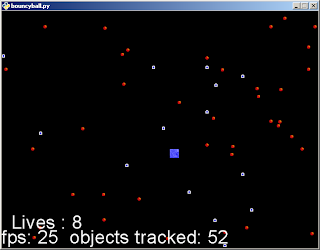# nice and simple first attempt at pyglet
from pyglet import window
from pyglet import clock
from pyglet import font
import pyglet
import random
import helper # (borrowed from example pygletspace program)
# it just loads images
class TheBounceWindow(window.Window):
def __init__(self, *args, **kwargs):
window.Window.__init__(self, *args, **kwargs)
self.set_mouse_visible(False)
self.init_sprites()
def init_sprites(self):
self.balls = []
self.ball_image = "ball.png" #helper.load_image("ball.png")
self.inactive_ball_image = "aball.png"
self.me_image = "me.png" # this is the player
self.me_ouch = "me.png" # player is hit image
self.me = Player( self.me_image, self.me_ouch, self.height, self.width)
def main_loop(self):
#fps indicator
ft = font.load('Arial', 28)
# text object to display the ft
fps_text = font.Text(ft, y=10)
# some stuff
clock.set_fps_limit(25)
while not self.has_exit:
self.dispatch_events()
self.clear()
self.update()
self.draw()
clock.tick()
fps_text.text = ("fps: %d") % (clock.get_fps())
fps_text.text += (" objects tracked: %s") %(str(len(self.balls)))
fps_text.draw()
self.flip()
#detect collisions
hits = self.me.collide_once(self.balls)
if hits != None:
#hits is the actual sprite that made contact
# should do something with it!
# do here
self.me.hits_i_can_take -= 1
self.me.playOuch()
#print "contact!"
def update(self):
for sprite in self.balls:
sprite.update()
self.me.update()
def draw(self):
for sprite in self.balls:
sprite.draw()
self.me.draw()
"""******************************************
Event Handlers
*********************************************"""
def on_mouse_motion(self, x, y, dx, dy):
self.me.setPoints(x,y)
def on_mouse_drag(self, x, y, dx, dy, buttons, modifiers):
self.me.setPoints(x,y)
def on_mouse_press(self, x, y, button, modifiers):
#print "click: %s, %s" %(str(x), str(y))
#print "button pressed: %s" %(str(button))
self.me.setPoints(x,y)
if (button == 1):
b = Ball(self.ball_image, self.inactive_ball_image, self.height, self.width)
b.setPoints(x,y)
self.balls.append(b)
if (button == 2):
for count in xrange(0,5):
b = Ball(self.ball_image, self.inactive_ball_image, self.height, self.width)
b.setPoints(x,y)
self.balls.append(b)
if (button == 4):
for count in xrange(0,10):
b = Ball(self.ball_image, self.inactive_ball_image, self.height, self.width)
b.setPoints(x,y)
self.balls.append(b)
class Sprite(object):
def __get_left(self):
return self.x
left = property(__get_left)
def __get_right(self):
return self.x + self.image.width
right = property(__get_right)
def __get_top(self):
return self.y + self.image.height
top = property(__get_top)
def __get_bottom(self):
return self.y
bottom = property(__get_bottom)
def __init__(self, image_file, inactive_image_file=None, image_data=None, **kwargs):
#init standard variables
self.image_file = image_file
if (image_data is None):
self.image = helper.load_image(image_file)
else:
self.image = image_data
# inactive image
if (inactive_image_file is None):
# then we don't want one
# just use the regular image
self.inactive_image = self.image
else:
self.inactive_image = helper.load_image(inactive_image_file)
self.x = 10
self.y = 10
self.contact = False
self.active = False
self.dead = False
#Update the dict if they sent in any keywords
self.__dict__.update(kwargs)
def draw(self):
if self.active:
self.image.blit(self.x, self.y)
else:
self.inactive_image.blit(self.x, self.y)
def update(self):
pass
def intersect(self, sprite):
"""Do the two sprites intersect?
@param sprite - Sprite - The Sprite to test
"""
return not ((self.left > sprite.right)
or (self.right <>
or (self.top <>
or (self.bottom > sprite.top))
def collide(self, sprite_list):
"""Determing ther are collisions with this
sprite and the list of sprites
@param sprite_list - A list of sprites
@returns list - List of collisions"""
lst_return = []
for sprite in sprite_list:
if (self.intersect(sprite)):
lst_return.append(sprite)
return lst_return
def collide_once(self, sprite_list):
"""Determine if there is at least one
collision between this sprite and the list
@param sprite_list - A list of sprites
@returns - None - No Collision, or the first
sprite to collide
"""
for sprite in sprite_list:
if (self.intersect(sprite) and sprite.active == True):
sprite.active = False
self.active = False
return sprite
return None
class Ball(Sprite):
def __init__(self, image_data, inactive_image_data, top, right, **kwargs):
self.initial_x_direction = (int(random.random() *10) + 1) %2
self.initial_y_direction = (int(random.random() *10) + 1) %2
if self.initial_x_direction == 1:
self.initial_x_direction = -1
else:
self.initial_x_direction = 1
if self.initial_y_direction == 1:
self.initial_y_direction = -1
else:
self.initial_y_direction = 1
self.y_velocity = (int(random.random() * 10) + 1) * self.initial_x_direction
self.x_velocity = (int(random.random() * 10) + 1) * self.initial_y_direction
# preload sound:
self.sound = pyglet.resource.media('shot.wav', streaming=False)
self.hit_sides = False
#self.velocity = 1
self.screen_top = top
self.screen_right = right
Sprite.__init__(self, image_data,inactive_image_file=inactive_image_data, **kwargs)
def update(self):
#print "%s %s" %(self.top, self.bottom)
if self.top > self.screen_top or self.bottom <>
self.hit_sides = True
self.active = True
self.y_velocity *= -1
if self.right > self.screen_right or self.left <>
self.hit_sides = True
self.active= True
self.x_velocity *= -1
self.y += self.y_velocity
self.x += self.x_velocity
if self.hit_sides:
self.sound.play()
self.hit_sides = False
def setPoints(self, x, y):
self.x = x
self.y = y
class Player(Sprite):
def __init__(self, image_data, image_contact, top, right, **kwargs):
self.screen_top = top
self.screen_right = right
Sprite.__init__(self, image_data, **kwargs)
self.hits_i_can_take = 10
self.sound = pyglet.resource.media('ouch.wav', streaming=False)
self.font = font.load('Arial',28)
self.kill_text = font.Text(self.font, x=20, y=40)
def draw(self):
Sprite.draw(self)
self.kill_text.text = ("Lives : %d") %(self.hits_i_can_take)
self.kill_text.draw()
def playOuch(self):
self.sound.play()
def setPoints(self, x, y):
self.x = x
self.y = y
if __name__ == '__main__':
bball = TheBounceWindow()
bball.main_loop()
vowels = 'a', 'e', 'i', 'o', 'u', 'y'
sentence = "My name is Werner Brandes, my voice is my password, verify me."
for vowel in vowels:
sentence = sentence.replace(vowel, '')
print sentence
'M nm s Wrnr Brnds, m vc s m psswrd, vrf m.'
